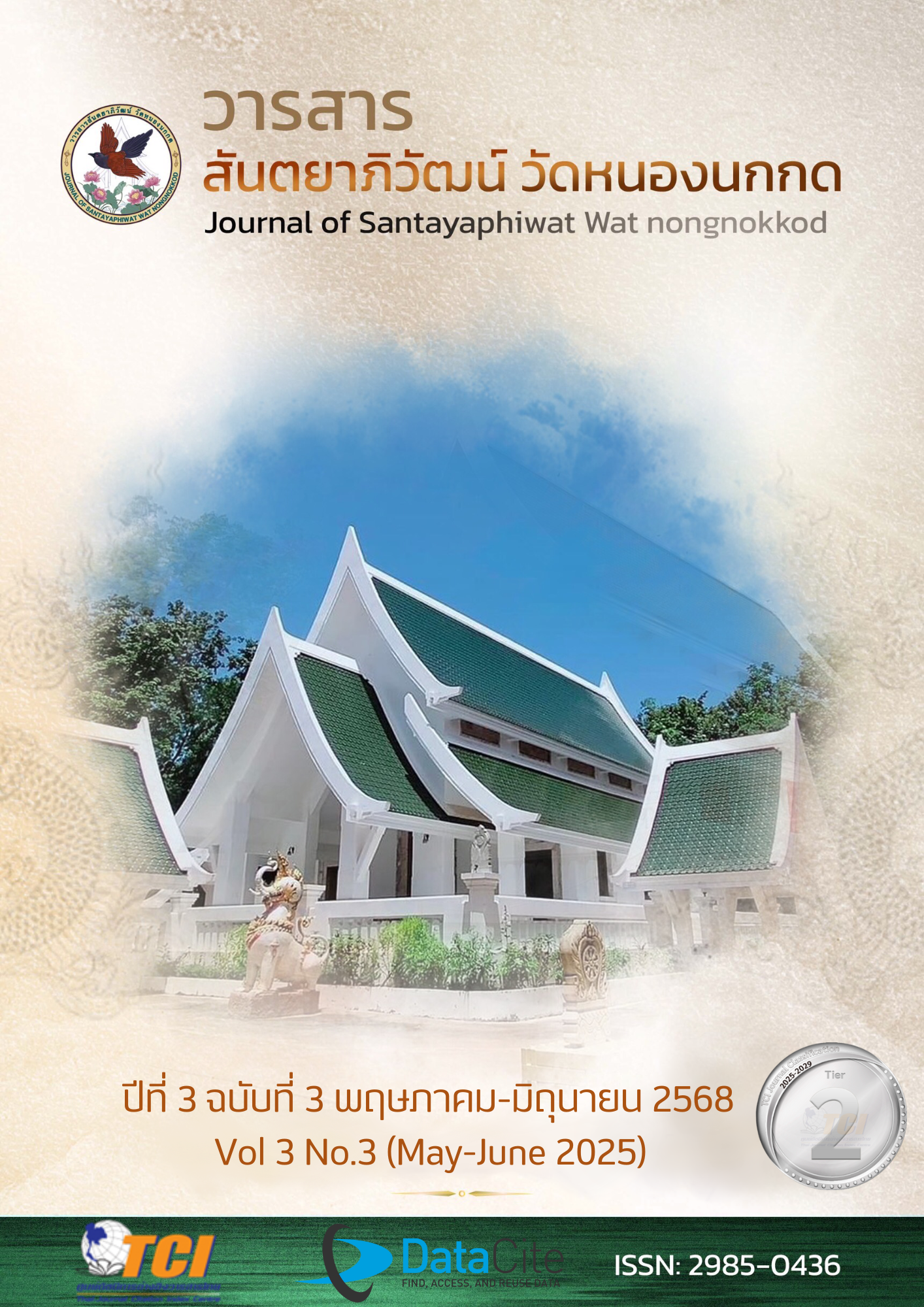COMPONENTS AND GUIDELINES OF PARTICIPATORY SAFETY MANAGEMENT OF SECONDARY SCHOOLS UNDER THE OFFICE OF THE BASIC EDUCATION COMMISSION
Keywords:
Safety management, Participatory, Secondary schoolsAbstract
This research aims to study components of participatory safety management in secondary schools under the Office of the Basic Education Commission, as well as the guidelines for implementing participatory safety management in these schools. The study employs a mixed-methods research approach: The study of the components of participatory safety management in secondary schools under the Office of the Basic Education Commission was conducted with a sample group of 331 school administrators. Data were collected using a five-point Likert scale questionnaire. The statistical methods used for data analysis included mean, standard deviation, and confirmatory factor analysis. The study of the guidelines for implementing participatory safety management in secondary schools under the Office of the Basic Education Commission was conducted through semi-structured interviews with seven experts, with data analyzed using content analysis. The research findings revealed that 1) the most significant component was safety culture, followed by safety measures, safety planning, safety atmosphere and environment, participation of safety-related networks, safety vision, strategy and goals, and safety leadership, respectively. The results from confirmatory factor analysis indicated that the model demonstrated a high degree of consistency with empirical data. 2) The guidelines for implementing participatory safety management in secondary schools under the Office of the Basic Education Commission consist of three key components: Part 1: Principles and objectives, Part 2: Components and guidelines for participatory safety management in secondary schools, and Part 3: Success factors.
References
กระทรวงศึกษาธิการ. (2553). หลักสูตรแกนกลางการศึกษาขั้นพื้นฐาน พุทธศักราช 2551.กรุงเทพฯ: โรงพิมพ์ชุมนุมสหกรณ์การเกษตรแห่งประเทศไทยจํากัด
กรมป้องกันและบรรเทาสาธารณภัย. (2552). ความปลอดภัยในโรงเรียน. กรุงเทพฯ : ฝ่ายผลิต. สื่อและสิ่งพิมพ์กรมป้องกันและบรรเทาสาธารณภัย.
พัชราภา ตันติชูเวช, สุมิตร สุวรรณ, วิทัศน์ ฝักเจริญผล และวินัย พูลศรี. (2565). กระบวนการสร้างวัฒนธรรมความปลอดภัยในโรงเรียนเพื่อป้องกันการรังแกกันของนักเรียน ในโรงเรียนสาธิตแห่งมหาวิทยาลัยเกษตรศาสตร์ วิทยาเขตกาแพงแสน. วารสารมนุษยศาสตร์และสังคมศาสตร์ นายเรืออากาศ, 2, 93-105
เมตต์ เมตต์การุณ์จิต. (2553). การบริหารจัดการศึกษาแบบมีส่วนร่วม: ประชาชน องค์กรปกครองส่วนท้องถิ่นและราชการ. กรุงเทพฯ: บุ๊ค พอยท์
ศูนย์ข่าวTCIJ. (2561). เด็กทั่วโลกกำลังเผชิญความรุนแรงในโรงเรียน ไทยปีละกว่า 600,000 ราย (อินเตอร์เน็ต). เรียกใช้เมื่อ 15 พฤศจิกายน 2567 จาก https://www.tcijthai.com/news/2018/02/scoop/8545
สำนักงานสาธารณสุขอ่างทอง. (2560). รายงานทารกน้ำาหนักน้อยกว่า 2,500 กรัม ได้รับการคัดกรองพัฒนาการ DSPMปีงบประมาณ 2560 (อินเตอร์เน็ต). เรียกใช้เมื่อ 15 มิถุนายน 2562 จาก http://atg.hdc.moph.go.th
สำนักนโยบายและแผนการจัดการศึกษาขั้นพื้นฐาน (2567) รายชื่อโรงเรียนสังกัด สพฐ. (อินเตอร์เน็ต) เรียกใช้เมื่อ 15 พฤศจิกายน 2567 จาก http://www.bopp.go.th/?page_id=878
สมาน อัศวภูมิ. (2567). รูปแบบและการพัฒนารูปแบบโดยการวิจัยในการบริหารการศึกษา. 6 (1), 414-426.
Gairín, J., & Castro, D. (2011). Safety in schools: an integral approach. International Journal of Leadership in Education, 14(4), 457–474.
Khan, A. U. R., & Jabeen, R. (2023). A Study on the Implementation of Safety Measures in Educational Institutions: A Conformity Analysis with the Pakistan School Safety Framework. Spry Contemporary Educational Practices, 2(2), 287-301
Lindfors, E., Somerkoski, B., & Korkeaniemi, A. (2024). Kouluorganisaatioiden turvallisuuskulttuuri omatoimisen varautumisen arvioinnin perusteella: Monitapaustutkimus perusopetuksen kouluissa. Hallinnon Tutkimus, 43(4), 284-300.
Ramzan, M., Tahira, R., Zaidi, S. F. A., & Naseem, U. (2024). Effect of Security Measures on Self Confidence of Teachers and Students at University Level. Open access education and leadership review, 1(2), 40-46.








